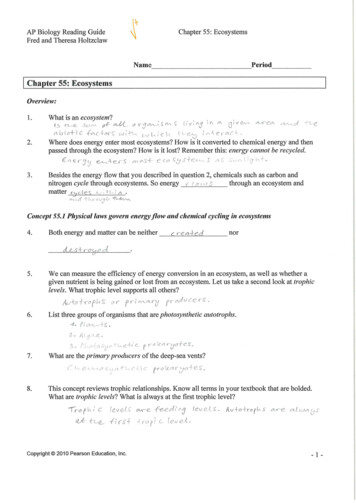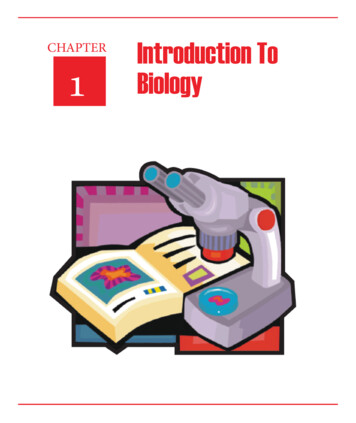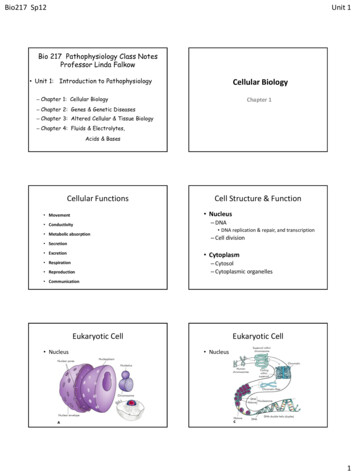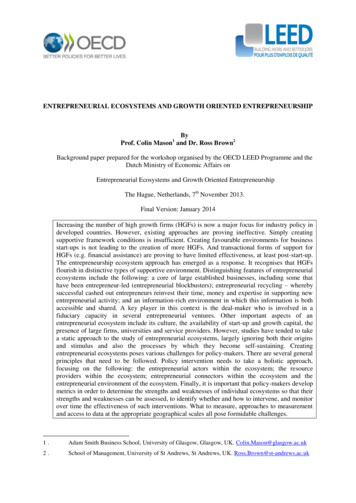
Transcription
Chapter 55: EcosystemsAP Biology Reading GuideFred and Theresa HoltzclawPeriodNameChapter 55: EcosystemsOverview:1.What is an ecosystem?2.Where does energy enter most ecosystems? How is it converted to chemical energy and thenpassed through the ecosystem? How is it lost? Remember this: energy cannot be recycled.or9e I SMS Uv n9 in 0'r5 4- --c- sv,,- ofet to 1' 0 -2 C -(Ac er- S w i 4-k,E n e r - g cj3.Se,- 4-ex-S n% oS-- e cc0'(V e--avr e'A'.-' S ; , (; v L'k 4 -Besides the energy flow that you described in question 2, chemicals such as carbon andnitrogen cycle through ecosystems. So energythrough an ecosystem andmatter c,,c- i e s; # t,Concept 55.1 Physical laws govern energy flow and chemical cycling in ecosystems4.c reek e dBoth energy and matter can be neithernorS r-o' e .o(5.We can measure the efficiency of energy conversion in an ecosystem, as well as whether agiven nutrient is being gained or lost from an ecosystem. Let us take a second look at trophiclevels. What trophic level supports all others?/ v ofroplAs or Pr'i ard6.Prod Ge S.List three groups of organisms that are photosynthetic autotrophs.4. N xt ,-4s.V7.What are the primary producers of the deep-sea vents?- s '- . : i. , i C., c" r Pro ZtAr- o " ' e S ,8.This concept reviews trophic relationships. Know all terms in your textbook that are bolded.What are trophic levels? What is always at the first trophic level?TroPlni CcrVe),S are -6eedi119 (e-vetS. Au ole-Fl r' S 4 q ro p iCopyright 2010 Pearson Education, Inc.ctre ct.(wa SC ( e- v e-C1
AP Biology Reading GuideFred and Theresa Holtzclaw9.What are detritivores? What is their importance in chemical cycling? Give some examples ofdetritivores.A r 2 GZQf Q M10.Chapter 55: EcosystemsO Se.r SP1. E f '0.-f non I I V'Lr l9 0 : C" M cif Cyr i oft -State the trophic level of each of the following:cow P r ; m a ry grass P r ;CnnsVMZr-maa . man .54' -j n',(QrJmushroomprcdueervo rt-65nSun .erConcept 55.2 Energy and other limiting factors control primary production in ecosystems11.What is primary production? Distinguish between gross primary production and net primaryproduction.IS12.('l .2 a .o u 'i oi l 'f P. 2r c f co /t V1 r"Write an equation here that shows the relationship between gross and net primary production./V PP G PP— RQ13.You may recall from Chapter 54 that biomass is the total mass of all individuals in a trophiclevel. Another way of defining net primary production is as the amount of new biomass addedin a given period of time. Why is net primary production, or the amount of new biomass/unit oftime, the key measurement to ecologists? r wry P adue-hion i S fiz .- ( yrbeta ise 1-f- re prese, s -N,.e- S 6,a e a,rc i !/ b e a ra r' (a G I e -f o e o f1 s u -ex-s t" a -f co S. "-Ta eco (o s s f14.ft, a j,Which ecosystem would tend to have a greater biomass/unit area, a prairie or a tropical rainforest? Explain.T {-ro P ', c a-( rain o r E' 4 w (I ( a ve tL—el0 Al aSS/v,,,48 reAq-e c 6lo e- b l 8 te r- A.Ve-- o a i la l waer15.Describe a technique for measuring net primary production in an aquatic environment.(We will use this technique for AP Lab 12, Dissolved Oxygen and Aquatic Primary Productivity.)16.What are some factors that limit primary productivity in aquatic ecosystems?r{ nr S Copyright 2010 Pearson Education, Inc.r0ro d U C "/V ri !ir .L J ra. t G r ' , r(c .,.,
AP Biology Reading GuideFred and Theresa Holtzclaw17.18.19.Chapter 55: EcosystemsWhat is a limiting nutrient? What is the limiting nutrient off the shore of Long Island, NewYork? In the Sargasso Sea?anom. v s-f eddled racrease.ror,( C ionPhytoplankton growth can be increased by additional nitrates and phosphates. What arecommon sources of each of these?Sew, no e oL,- d fe-r--( I i ' C r r u I N 0-fj- f ro AII ea(a wA Sa"re A COnL -i vof) Soo r[e o-r- Qe d i -f - 'o ie- fWhat is eutrophication? What are factors that contribute to eutrophication?S w I 2re a boo(.Jre G2i ve St f. oA etn (, a---- C e- Q C a- a 6a C f e r C q Concept 55.3 Energy transfer between trophic levels is typically only 10% efficient20.What is trophic efficiency?erc e. { le21.or ?c;{ n -( ra . , s F rr a( ern MGenerally, what percentage of energy available at one trophic level is available at the next?This is important!Remember it.22.Consider a food chain with 1,000 joules (an energy unit) available at the producer level. If thisfood chain is grass 4 grasshopper 4 lizard 4 crow, how much energy is found at the level ofthe crow? (See answer at the end of this Reading Guide.) Show your work here.SSl OOOCopyright 2010 Pearson Education, Inc.3
AP Biology Reading GuideFred and Theresa Holtzclaw23.Chapter 55: EcosystemsNotice that most biomass pyramids have greatest biomass on the bottom of the pyramid. Labelthe trophic levels on the figure. Explain why the second pyramid of biomass is inverted.ca AoL fy ca n sv -ex-sero eonSun,vc SALI-11'4I t a r--j Co e\ S u A--e r5 ( -e oo P ( et ,-- 1 a )24.Why do people who have limited diets in overpopulated parts of the world eat low on the foodchain?Ir eoPle. eA - 'I1 l Q L .w4, rn -iCrt/.1 t 11M O re --{' t ) ct U t r ct .Concept 55.4 Biological and geochemical processes cycle nutrients between organic and inorganicparts of an ecosystemPay particular attention to the nutrient cycles in Figure 55.14. Note the key processes in each cycle.25.Use the figure below to describe the water cycle. Specify the roles of evaporation,transpiration, and rainfall.,tL.eT'e-&d C- e va pa ra -ion of V,7,u (%d (.)aker bb So l a,req26.Use the second figure on the following page to describe the carbon cycle. In doing so, explainhow carbon enters the living system and how it leaves, indicate the role of microorganismsin the cycle, and identify the reservoir for carbon.Pkot0 34 A t eS- s b. 9 P (a. -fSd o 1a, .l -0 preMoVGS Su b5-1- -COZ eaGrr ese-r Copyright 2010 Pearson Education, Inc.4
AP Biology Reading GuideFred and Theresa HoltzclawChapter 55: EcosystemsC , M i ?- 6 -Write the equation for photosynthesis here: 6 CO, /-1z4(07Write the equation for cellular respiration here: G & H i z4 /, - --- ee y 6 H z 0 t A T P(4D Vc' .t. . -e-nI t L .01(ar eci f( ai ioA,, ver low dWv )1 ".toA 'E,va ral o averf P A irG lad foi "(6, 00 31Iydid,-o / "27.Use the diagram below to describe the nitrogen cycle. In doing so, indicate the role ofmicroorganisms in nitrogen fixation, nitrification, and denitrification.cle "it'ri -FiC' i anJV .J0r1sV"ni -roe e, - V1X a fion t lCOAVerSton o NZ fo o r M S - Z.a-F- ca.,. (o e usednc -ircVie—:uyy oY,tn wren -air.n f ' l w n F,r.n c r ;.Copyright 2010 Pearson Education, Inc.caM P3"'7cS
AP Biology Reading GuideFred and Theresa Holtzclaw28.Chapter 55: EcosystemsReview the Case Study: Nutrient Cycling in the Hubbard Brook Experimental Forest. Whateffect has deforestation been shown to have on chemical cycling?AAa -tC i creased -n. F'towo- w e -- cn. -. d nn i ne IS (Pa , n Concept 55.5 Human activities now dominate most chemical cycles on Eartht --F wai-ersl -ed.This section looks at human impact on ecosystems.29.How has agriculture affected nitrogen cycling? What are some negative consequences ofnutrient enrichment?i cey lave i n C r e ek s eA( -t,,.e ,,. ,' " 4- ofA 9 r ,' cu ( v r-0, . fraL AA A- C,—' 0J, Sn 0 9 Fes. ou S30.In what ways have human activities contributed to acid precipitation? What are some negativeconsequences of acid precipitation? 0 X e C4 p-t— ,l.t V '0" S i-e 1O- 0. S e c-,''L. vSa.-.dS of S yn t etic co .Pou dS Pr-ev20vs1 0 unknawnt -ft-te. r 9ard for- e. ecoloy c'a,C ttr Seq,v .cesExplain the process of biological magnification. Discuss at least one example.nn o re. tan . . fv cd in sv eeec i veA c c u N., cl 1 a, - e d Oro u i- s t a c o31. ,rorv,, r leveA(S o-- c , -696d web.32.What is meant by the greenhouse effect? What would life on Earth be like without this effect?&-o(ex're-af7i1GL % on;S reflec-4F bac(c o sP c .33.What is contributing to the great increase in atmospheric carbon dioxide? What are potentialeffects of this increase?Foss" l34.e bury ng couldconF f ;bo e iot1- c arntiin oHow is atmospheric ozone depleted? What are projected effects of this depletion?ozane rS , :arilTesting Your Knowledge: Self-Quiz Answers w z oCo,( 5 ; nto nA1 -A"uf"LC'Ivr i n J.Now you should be ready to test your knowledge. Place your answers here:1.2.3.4.5.6.7.Solution to Question 22: Grass (1,000 J) -grasshopper (100 J) 4 lizard (10 J) 4 crow (1 J)Copyright 2010 Pearson Education, Inc.-6
AP Biology Reading Guide Chapter 55: Ecosystems Fred and Theresa Holtzclaw 17. What is a limiting nutrient? What is the limiting nutrient off the shore of Long Island, New York? In the Sargasso Sea? a nom. v s-f e ddled ra ror,( C_ ion crease. 18. Phytoplankton growth can be







![Ecosystems 5E Lesson Plan for Grades 3-5 [PDF]](/img/22/ecosystems-lesson-plan-gg.jpg)


